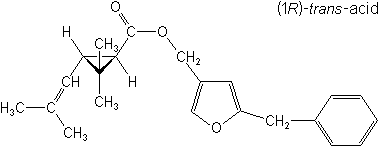-
Common NameBioresmethrin
-
中文通用名生物苄呋菊酯
-
IUPAC5-benzyl-3-furylmethyl (1R,3R)-2,2-dimethyl-3-(2-methylprop-1-enyl)cyclopropanecarboxylate
or
5-benzyl-3-furylmethyl (1R)-trans-2,2-dimethyl-3-(2-methylprop-1-enyl)cyclopropanecarboxylate -
CAS[5-(phenylmethyl)-3-furanyl]methyl (1R,3R)-2,2-dimethyl-3-(2-methyl-1-propenyl)cyclopropanecarboxylate
-
CAS No.28434-01-7
-
Molecular FormulaC22H26O3
-
Molecular Structure
-
Physical PropertiesMolecular weight:338.4; Physical form:Tech. bioresmethrin is a viscous yellow to brown liquid, which partially solidifies on standing. Tech. d-resmethrin is a colourless to yellowish liquid, sometimes partially crystalline at room temperature. Density:1.050 (20 °C); d-resmethrin 1.040 (25 °C); Composition:Tech. grade contains ×93% total isomers, of which ×90% is the (1R)-trans- isomer and ×3% is cis- isomers. d-Resmethrin contains ×95% (1R)- isomers, ×75% tra Melting point:32 °C; Flash point:c. 92 °C; Vapour pressure:18.6 mPa(25 °C) (gas saturation method). Tech. d-resmethrin 0.45 mPa (20 °C); Partition coefficient(n-octanol and water):logP >4.7; Solubility:In water <0.3 mg/l (25 °C). Soluble in ethanol, acetone, chloroform, dichloromethane, ethyl acetate, toluene and hexane. In ethylene glycol <10 g/l. d-Resmethrin: in water 1.2 mg/l (30 °C); in xylene 50% (25 °C).; Stability:Decomposes above 180 °C, and under u.v. light. Readily hydrolysed in alkaline media. Sensitive to oxidation. d-Resmethrin decomposes under u.v. light. Readily hydrolysed in alkaline media.;
-
ToxicologyOral:Acute oral LD50 for rats 7070-8000 mg/kg; dissolved in corn oil ×5000 mg/kg; for male rats 450, female rats 680 mg tech.50 for female rats >10 000, rabbits >2000 mg/kg. Inhalation: LC50 (4 h) for rats 5.28 mg/l air, (24 h) 0.87 mg/l air; (4 h) for rats 1.56 mg/ tech. d-resmethrin/l air.
-
Environmental ProfileEcotoxicology:
Bees:Very toxic to honeybees; LD50(oral) 2 ng/bee; (topical) 6.2 ng/bee.Birds:Acute oral LD50 for chickens >10 000 mg/ kg.Daphnia: LC50 (48 h) 0.0008 mg/l.Fish:LC50 (96 h) for harlequin fish 0.014, guppies 0.5-1.0, rainbow trout 0.00062, bluegill sunfish 0.0024 mg/l; (48 h) for harlequins 0.018, guppies 0.5-1.0 mg/l. Despite high toxicity to fish in l
Environmental fate:
Animals:Metabolism in rats was principally by oxidation reactions in the isobutenyl methyl groups, by ester cleavage and conjugation reactions.Soil:Strongly adsorbed on soil.Plant:In studies on tomatoes, very little material (entirely as degradation products) penetrated the skin. Similar results were obtained on cucumbers, but bioresmethrin on the skin of cucumbers is degraded more quickly than on tomatoes. -
Transport InformationHazard Class:III(Slightly hazardous)
Porduct NewsMore
Orthosulfamuron boosts sugarcane production, study finds
Glyphosate price plummets 40% in one year in Argentina
Indian govt stops imports of herbicide Glufosinate priced below Rs 1,289 per kg
Carbendazim fungicide wins victory in Brazilian Parliament
Corteva presents new pre-emergent herbicide Linear for sugarcane in Brazil
Picloram Triclopyr Aminopyralid
Revolutionizing disease prevention: BASF launches new rice fungicide Cevya® in China
Thiamethoxam is allowed again in Brazil by a judicial decision
Bayer develops alternative to glyphosate herbicide

 0
0 Subscribe
Subscribe
